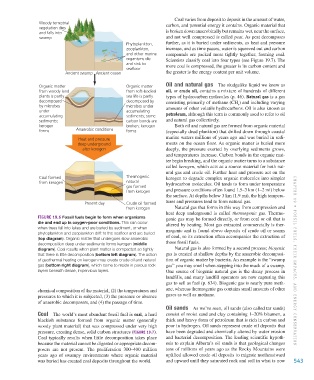Page 544 - Environment: The Science Behind the Stories
P. 544
Coal varies from deposit to deposit in the amount of water,
Woody terrestrial carbon, and potential energy it contains. Organic material that
vegetation dies
and falls into is broken down anaerobically but remains wet, near the surface,
swamp and not well compressed is called peat. As peat decomposes
Phytoplankton, further, as it is buried under sediments, as heat and pressure
zooplankton, increase, and as time passes, water is squeezed out and carbon
and other marine compounds are packed more tightly together, forming coal.
organisms die Scientists classify coal into four types (see Figure 19.7). The
and sink to more coal is compressed, the greater is its carbon content and
seafloor
Ancient swamp Ancient ocean the greater is the energy content per unit volume.
Organic matter Organic matter Oil and natural gas The sludgelike liquid we know as
from woody land from soft-bodied oil, or crude oil, contains a mixture of hundreds of different
plants is partly sea life is partly types of hydrocarbon molecules (p. 46). Natural gas is a gas
decomposed decomposed by consisting primarily of methane (CH ) and including varying
4
by microbes microbes under amounts of other volatile hydrocarbons. Oil is also known as
under accumulating
accumulating sediments; some petroleum, although this term is commonly used to refer to oil
sediments; carbon bonds are and natural gas collectively.
kerogen broken; kerogen Both oil and natural gas are formed from organic material
forms Anaerobic conditions forms (especially dead plankton) that drifted down through coastal
Heat and pressure marine waters millions of years ago and was buried in sedi-
deep underground ments on the ocean floor. As organic matter is buried more
alter kerogen deeply, the pressure exerted by overlying sediments grows,
and temperatures increase. Carbon bonds in the organic mat-
ter begin breaking, and the organic matter turns to a substance
called kerogen, which acts as a source material for both nat-
ural gas and crude oil. Further heat and pressure act on the
Coal formed Thermogenic kerogen to degrade complex organic molecules into simpler
from kerogen natural hydrocarbon molecules. Oil tends to form under temperature
gas formed
from kerogen and pressure conditions often found 1.5–3 km (1–2 mi) below
the surface. At depths below 3 km (1.9 mi), the high tempera-
Present day Crude oil formed tures and pressures tend to form natural gas.
from kerogen Natural gas that forms in this way from compression and
heat deep underground is called thermogenic gas. Thermo-
FIGURE 19.6 Fossil fuels begin to form when organisms genic gas may be formed directly, or from coal or oil that is
die and end up in oxygen-poor conditions. This can occur altered by heating. Most gas extracted commercially is ther-
when trees fall into lakes and are buried by sediment, or when mogenic and is found above deposits of crude oil or seams
phytoplankton and zooplankton drift to the seafloor and are buried
(top diagram). Organic matter that undergoes slow anaerobic of coal, so its extraction often accompanies the extraction of
decomposition deep under sediments forms kerogen (middle those fossil fuels.
diagram). Coal results when plant matter is compacted so tightly Natural gas is also formed by a second process; biogenic
that there is little decomposition (bottom left diagram). The action gas is created at shallow depths by the anaerobic decomposi-
of geothermal heating on kerogen may create crude oil and natural tion of organic matter by bacteria. An example is the “swamp CHAPTER 19 • FOSSIL FUELS, THEIR IMPA CT S, AND ENERGY CONSERVATI ON
gas (bottom right diagram), which come to reside in porous rock gas” you may smell when stepping into the muck of a swamp.
layers beneath dense, impervious layers. One source of biogenic natural gas is the decay process in
landfills, and many landfill operators are now capturing this
gas to sell as fuel (p. 634). Biogenic gas is nearly pure meth-
chemical composition of the material, (2) the temperatures and ane, whereas thermogenic gas contains small amounts of other
pressures to which it is subjected, (3) the presence or absence gases as well as methane.
of anaerobic decomposers, and (4) the passage of time.
Oil sands As we’ve seen, oil sands (also called tar sands)
Coal The world’s most abundant fossil fuel is coal, a hard consist of moist sand and clay containing 1–20% bitumen, a
blackish substance formed from organic matter (generally thick and heavy form of petroleum that is rich in carbon and
woody plant material) that was compressed under very high poor in hydrogen. Oil sands represent crude oil deposits that
pressure, creating dense, solid carbon structures (FIGURE 19.7). have been degraded and chemically altered by water erosion
Coal typically results when little decomposition takes place and bacterial decomposition. The leading scientific hypoth-
because the material cannot be digested or appropriate decom- esis to explain Alberta’s oil sands is that geological changes
posers are not present. The proliferation 300–400 million tens of millions of years ago as the Rocky Mountains were
years ago of swampy environments where organic material uplifted allowed crude oil deposits to migrate northeastward
was buried has created coal deposits throughout the world. and upward until they saturated rock and soil in what is now 543
M19_WITH7428_05_SE_C19.indd 543 12/12/14 5:22 PM

